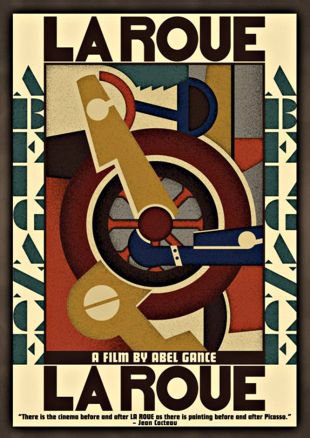A stage actor at 19, Frenchman Abel Gance appeared in his first film, Moliere, in 1909. Two years later, with La Digue, he was writing and directing as well. He quickly earned distinction both as an innovator, with the distorted-mirror sequence of his 1915 mad-scientist comedy La Folie Du Docteur Tube, and for his romantic dramas of the late teens, Mater Dolorosa and La Dixième Symphonie. Briefly conscripted late in World War I, Gance re-enlisted so he could return with cameras to film the soldiers under fire. That footage was woven into his anti-war drama J'Accuse, which overwhelmed postwar audiences with its realism and its stylized, high-velocity editing.
In La Roue, a romantic-triangle drama played out against images of railroad trains, Gance threw himself further into violent cutting and vivid locations. The lengthy film made him internationally famous, and Gance found funding for Napoleon (also known as Napoleon Vu Par Abel Gance), an epic biography which traces Bonaparte from his boyhood to the start of the Italian campaign. Gance's camerawork achieved a new fluidity and daring in Napoleon, the camera flying through the air on wires or strapped to a horse. His editing also became more intense, both his crosscutting in the "Double Tempest" scene, and even within a single frame, when a schoolboy pillow-fight erupts into multiple split screens. To capture the geographic vista and legions of extras for Napoleon's entry into Italy, Gance created Polyvision, a Cinerama prototype employing three synchronized cameras. But the Polyvision finale of Napoleon doesn't restrict itself to a single new frame; Polyvision can also be a central panel with symmetrical wings of action, or even three separate frames, each crackling with its own hallucinatory editing and superimposition.
Napoleon caused a sensation when it was premiered in 1927, but the complexities of its exhibition proved its undoing, especially with the changeover in technology from silent films to sound. Gance's masterpiece eventually became a lost work, and his career never recovered; his sound output was mostly assigned projects over which he had no creative control. The exceptions are two visionary films from the mid 1930s: Un Grand Amour De Beethoven (also known as Beethoven), where his treatment of sound is as daring as his editing, and his remake J'Accuse, with disfigured combat veterans portraying the resurrected war dead. Periodic efforts to revive Napoleon proved futile until the 1980 premiere of film historian Kevin Brownlow's reconstruction. Shown in Polyvision with a live orchestral score, Napoleon became an international triumph --which Gance lived long enough to enjoy.


